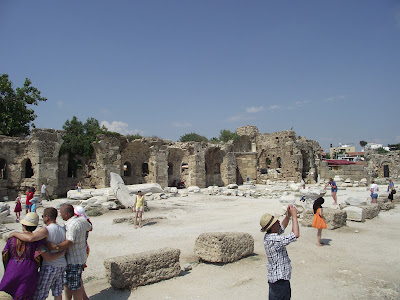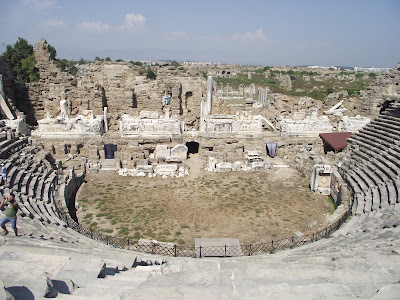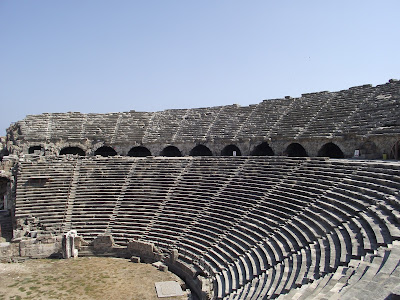The WRG 6th Edition Years
Whilst labelling the second Carthaginian army blocks last night I got to mulling over the rise and fall and rise again of my interest in Ancient wargames. It is ironic that the first army I am labelling for this latest iteration is the Carthaginians - simply because they were the very first Ancients army I owned - back in the dim and distant days of the early 1980s. At the time I was a member of the now defunct Newham Wargames Club that used to meet at Eric Knowles's shop in East London - New Model Army, in Manor Park. A number of the members were 'into' 6mm ancients using WRG 6th edition. the armies were truly enormous and 20,000 points a side was not uncommon (and I might add, usually unplayable!). The top two armies as I recall were Heraclian Byzantine and Sassanid Persian. I was intrigued but never really fancied 6mm as a scale but help was at hand as a number of other members of the club used both 15mm and 25mm and so my interest naturally gravitated to them. It was not long before an opportunity to acquire the start of an army was presented to me by my long time friend and frequent gaming nemesis - Chris Hardman. The army in question was the remnants of his 25mm Carthaginian force, abandoned after WRG 5th edition came out with, if I remember correctly, celebrated (if that is the right word) by the rise of E type archer and the domination of the battlefield by firepower. The transaction was speedily concluded and so I had the nucleus of an army. Some elements needed rebasing and I also had to add some additional figures although not too many. The figures used were a mixture of Minifigs and Garrison and I was very pleased that I was able to replicate almost exactly the painting technique then used (I could no more do that today than sprout wings and fly!).
The armies debut was against Chris Hardman's Seleucid force at Present Arms (a great show but alas no longer on the calender) in Rochford, Essex. As I recall we fought with 2,000 points and the game lasted I think around 3 turns. A sole unit of Seleucid Cataphracts rode roughshod over all of my cavalry (cunningly deployed so as to ensure that when the first unit routed it would happily collide with the one behind it; it turn colliding with the next one and so on - it was not pretty) and my enduring memory of that particular drubbing was that it took longer to set up than to play. Despite this setback my enthusiasm was undimmed.
Over a period of around three years I fought numerous armies and aside from the drubbing described above I only really lost badly to a Late Roman army. I refought Chris and his Seleucids only once more and although I had lost again, it was very much closer than the first time. What usually happened with this army was that it would fight the opposition to a standstill. I quickly learned that fighting was as few points as possible was better because everything in the army was cheap in terms of points costs. I also made extensive use of flank marches - especially with the Numidian Light Cavalry - and by maxing out the number of these horsemen it was rare that I was outscouted (except by the thrice cursed Seleucids!). I had also acquired a 15mm Carthaginian army and with this I had the opportunity to fight, joy of joys, a Republican Roman army. As I recall I fought this particular army on half a dozen occasions and every game ended in a draw. Clearly a pattern was emerging here.
I really enjoyed using the Carthaginians but it was a difficult army to win with. Virtually everything was average C class although the option existed to have a smattering of types upgraded to B. There were few troops with Heavy armour and the cavalry, although numerous, was lighter in weight than most of the available opposition and without a lance in sight. I always felt that you had to fight your socks off with this army just to get a draw. I was happy in the choice of historically based tactics I was trying to use and they often worked out quite well but invariably either opposition quality or weight would tell. Looking back I can now see that my impressions of the army were largely correct in that in order to get the disparate elements to work efficiently you needed the genius of a Hannibal to succeed.
I wanted to own an army that would give me a variety of quality options to use and above all, be a balanced force. So I opted for what appeared to be the answer to a frustrated wargamers dream army - Late Imperial Roman. The army I acquired was Essex 28mm figures and professionally painted. It was a delight to look at, a joy to use and fought exactly three times before I sold it. I beat a Later Roman and a Sassanid army but lost out to an army of Franks. It felt plain wrong using an army purely for the gaming effect under the rules and at the time I had no interest in the period in which the army fought. I also owned an Early Indian army, complete with its full quota of B class elephants. Again, this was a cynical acquisition as at the time I had no interest in the period the army in question operated in. Again, it was a fun but shallow experience. I do remember though the glorious occasion when a general led unit of 9 Irregular B elephants went 'Impetuous' at the top of a hill and charged into a legion throwing the maximum plus it was able to in the ensuing melee - the carnage was magnificent! I disposed of both armies as my disillusion with 6th edition was complete. It was not the rules by any means, it was simply due to the fact that I had to consistently fight armies either geographically or historically remote from those that I chose to use. The latter pair of armies were certainly a triumph of style over substance. I also considered acquiring an Alexandrian Macedonian army with all the extras. Carefully constructed this would furnish a number of 1,100 point armies enabling games to be fought entirely from my own collection. I did a lot of research on this army but never followed it through - mainly because of difficulties with the firm I was using to paint the figures.
As the end of my first Ancients phase drew to a close I did have a couple of 'Plan Bs' on the go. I rather fancied a Parthian army and also looked long and hard at an Arab Conquest collection. I actually researched both of these armies and acquired some figures but due to real life intervening never pursued the ideas. The armies of the Middle East have always held an attraction for me and so this was probably an early indication of where and how my interests would develop in time.
The DBA Years
For me (and probably a good few others), the publication of DBA was one of the biggest events in my wargaming career and it is safe to say restored my faith in the Ancient period as a wargames option. An army of 12 bases? This seemed like blatant heresy to all those brought up on a diet of 300 plus figures for an army. I loved them from the off and have fond memories of cutting out card bases and fighting eight games in an afternoon in the garden whilst supervising a barbecue (doubtless with a drink or two). I lost 7 - 1 but 5 of the games went to the wire. Ironically the single game I won was using, yes, you've guessed it, Carthaginians. I have played a number of games using this over the years and have owned many armies - only one of which was ever painted. The painted army was an Essex Miniatures 15mm Numidian and the only reason I opted for this was because it covered a long historical timeframe and was also easy to paint. It was quite successful but I got bored and offloaded it for what seemed like an obscene price at the time.
I have probably played more games using DBA variants that the base game itself and that is testimony to the soundness of the design and concept. The only thing for me is that a single DBA 'army' looks too small in terms of the figures used. A single DBA army can only really be used for DBA whereas a 'normal' sized army (and if anyone could tell me what 'normal' is then I would be eternally grateful!) can, theoretically furnish several DBA armies. At the very least this would cover a civil war. The 28mm DBA gamers (or HOTTs to be accurate) at my club routinely use double sized DBA armies as they look far better with greater numbers of figures in use. The advice concerning buying armies in matched pairs is sound and I would certainly not consider buying a DBA army in isolation - in fact, if I ever considered using figures for the period I would aim to get all the armies for any one of the stylised 6 sided campaigns suggested in the rules. My own feeling, and having seen this approach in action, is that using double sized armies, or even double sized elements, adds immeasurably to the look of the thing.
As a campaign 'tool' DBA is ideal and has been used with some success in the past at my club. With the Command and Colours Ancients blocks at my disposal the 6 sided DBA campaign is a certainty in terms of being achievable for my own nefarious purposes.
The 'Dawn' of the Command and Colours Years
Regular readers of the blog will no doubt be aware of the fact that I am a huge fan of the whole Command and Colours series of games designed by Richard Borg. From the original Battle Cry ACW game through to the Napoleonic version via Ancients and WW2 I have had enormous fun with them all. As a game system it has everything that I want from a set of rules being easy to play, fast, decisive, readily adaptable and easily translated into a tabletop setting. The rules are not perfect (show me a set that is!) and they could readily stand having degrees of complexity added to them (especially Memoir 44 although this is heading that way) to bring them into line with more 'mainstream' wargames rules. I am also not a huge fan of the command cards idea although my opposition towards using the same is being gradually eroded! I really enjoy using them for face to face play but have yet to find a solo version that 'does it' for me although to be honest I have not really tried that hard as yet. If Richard Borg and GMT ever tackle any other periods using blocks I would be on it in a flash - regardless of the period covered!
I plan to use the C and C Ancients blocks on bases with a block effectively representing a figure. As the infantry blocks usually have pictures of 2 figures on them straightaway the visual look is improved as the 4 blocks of a heavy or medium close ordered infantry unit will have 8 figures in view. Smoke and mirrors perhaps, but it is an illusion that I am more than happy to make use of. The only problem I need to resolve concerns the basing aspect. In order to deploy four infantry blocks in a single line the base needs to be larger than the 60mm frontage used for 28mm figures. the blocks comfortably fit on an 80mm frontage - which is the frontage that has been adopted by some of the 28mm armies in use at the club, simply because of the size of the figures. I will try to keep to the minimum depths if I can which will not be a problem for hex based games but will give armies under DBA a broader frontage but a narrower depth. In order to hold the blocks in position I am planning to have a channel on the base - probably from a couple of lengths of plastic strip - into which the blocks can sit. They will not be fixed in place permanently, merely there to be moved around en masse.
With the variety of armies I shall have available the potential for campaigns or one off games is, quite simply, huge. The Salamis idea can now be realised (giving me an excuse to paint some galleys) and my long held interests in the campaigns of Hannibal, Alexander and Caesar can all get a look in. The Spartacus Revolt or even the opening battle from the film Gladiator are also now in sight and so this will enable me to indulge in pretty much any historical flight of fancy from 600 BC to fall of the Empire in the West.
So there you have it, a potted overview of the story of my dabblings in Ancients and how I have reached the point I am now at - tackling a thousand years or so of military history using a couple of rule sets, Hexon terrain and an ordinary tabletop and blocks. Lots of blocks....;-)




























